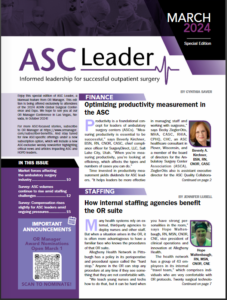
 Subscriber Content ICD-10 conversion uneventful in the ambulatory setting, despite worries
Subscriber Content ICD-10 conversion uneventful in the ambulatory setting, despite worries
With several months of experience using an updated version of the International Classification of Diseases-10 (ICD-10) diagnosis coding system, most US healthcare providers, including ambulatory surgery centers (ASCs), are finding their worst fears have yet to materialize. ‘Lights would go out’ Although Medicare has not yet released data, insurance…
 Subscriber Content Recovery centers extend stays beyond 24 hours
Subscriber Content Recovery centers extend stays beyond 24 hours
One of the last things ambulatory surgery center (ASC) staff want to do is transfer a patient to a hospital because it increases the risk of infection and patient discomfort, and it’s a Centers for Medicare & Medicaid Services (CMS) quality measure (ASC-4). CMS and most states traditionally have not…
 Subscriber Content Fine print in supply contracts often holds keys to cost savings
Subscriber Content Fine print in supply contracts often holds keys to cost savings
When it comes to buying medical-surgical supplies, quality, safety, and physician comfort are foremost—but that doesn’t mean price is no object. Even though ambulatory surgery center (ASC) staff often lack materials management expertise, they can achieve cost savings in several ways, especially if they brush up on terms used in…
 Subscriber Content Disaster planning exercises prepare ASCs to care for patients and assist communities
Subscriber Content Disaster planning exercises prepare ASCs to care for patients and assist communities
Ambulatory surgery centers (ASCs) are taking a new look at the question of disaster response. Staff are not always informed about what emergencies might occur, or what they should do in response to the most likely scenarios. Likewise, many local emergency management agencies are not even aware of the ASCs…
 Subscriber Content Surveyors reveal how to get credit for credentialing
Subscriber Content Surveyors reveal how to get credit for credentialing
Credentialing of physicians and other independent practitioners is facing increased scrutiny from surveyors, professional associations and, in some cases, the public—not necessarily because of compliance failures but because healthcare legislation and technology improvements have made the process a conversation topic. Thus it may be a good time to review the…
 Subscriber Content Empowering staff yields high return on investment
Subscriber Content Empowering staff yields high return on investment
Building healthy relationships between leaders and employees is vital to the success of any organization. It’s especially important in perioperative services because of the teamwork needed to provide safe patient care. OR leaders must invest in their employees by fostering trust, job embeddedness, and employee commitment, empowerment, and accountability. …
 Subscriber Content ASC survey respondents stepping up to meet challenges
Subscriber Content ASC survey respondents stepping up to meet challenges
What were you doing in 1991? OR Manager was launching its annual Salary/Career Survey, and in reporting results of this year’s survey, we have included some “fun facts” from the past. One fact is that the average salary for ASC managers has risen from $43,887 in the survey’s first year…
 Subscriber Content Successful recruitment and retention of engaged employees--Part 2
Subscriber Content Successful recruitment and retention of engaged employees--Part 2
—Part 1 of this two-part series, published in the September issue of OR Manager, discussed staff engagement and how to hire engaged staff. Once staff are hired, it’s important to keep them engaged and measure the level of engagement. This article describes how to do that. How do you…
 Subscriber Content Risk assessment and remedial action required to curb infections
Subscriber Content Risk assessment and remedial action required to curb infections
They are so attractive, those surgeons with rakish beards, those nurses with sparkling manicures, those surgical technologists with dangling earrings. Unfortunately, what is acceptable in many other workplaces is an invitation to infection in the surgical arena (and other healthcare settings as well). Jean Day, BSN, CNOR, director of education…
 Subscriber Content Quality reports to determine pay rise or fall
Subscriber Content Quality reports to determine pay rise or fall
Ambulatory surgery centers (ASCs) that have yet to register and report compliance with quality measures can expect a decrease of 0.9% in 2016 from this year’s Medicare reimbursement rates. Those in compliance, however, may see an increase of approximately 1.1%, depending on specialties. As in the past, the Centers for…


